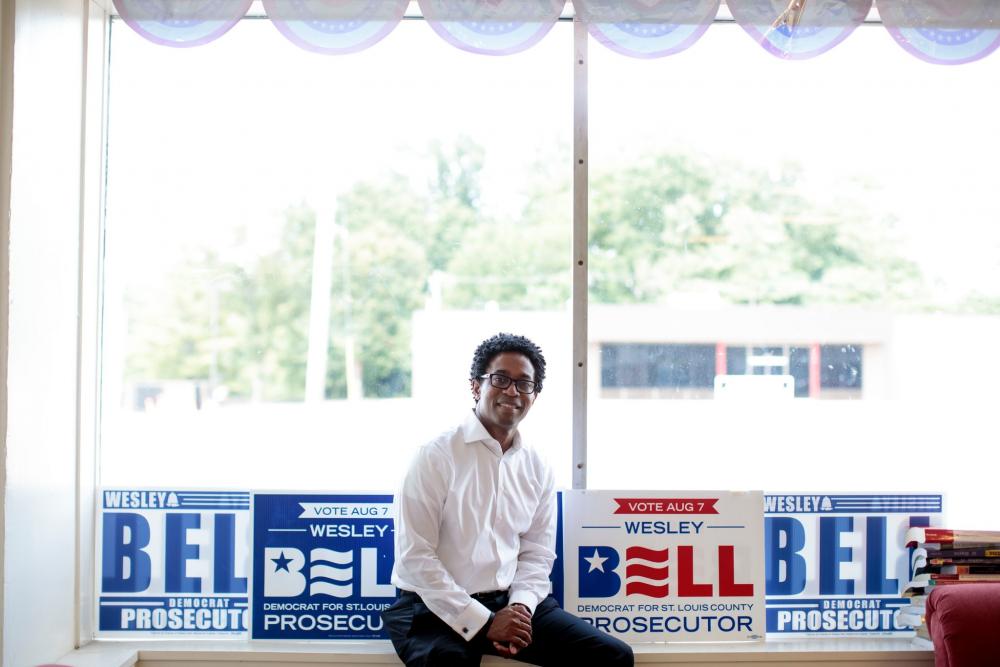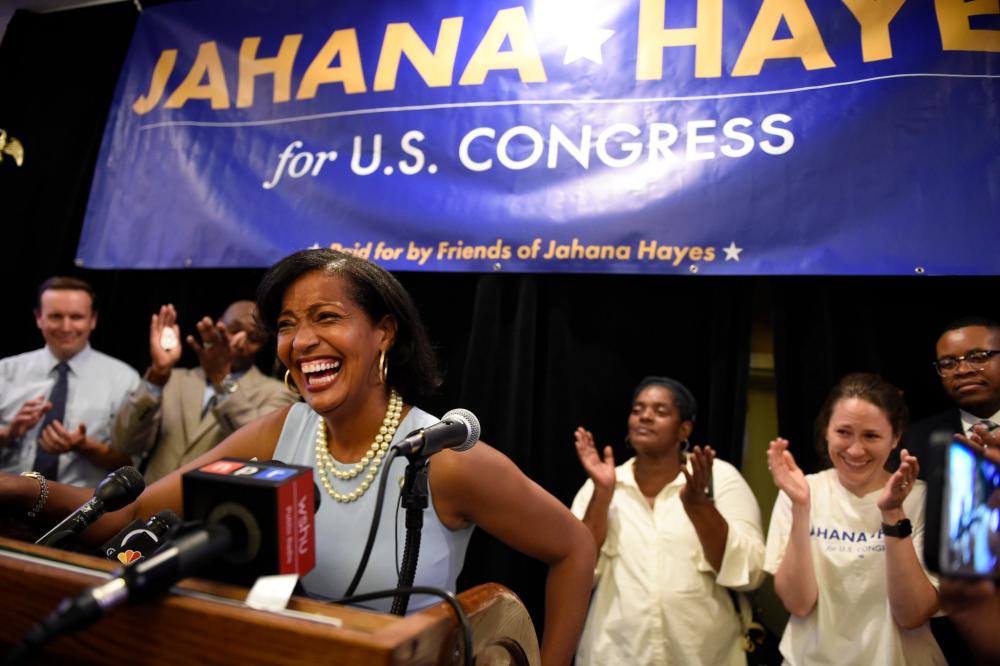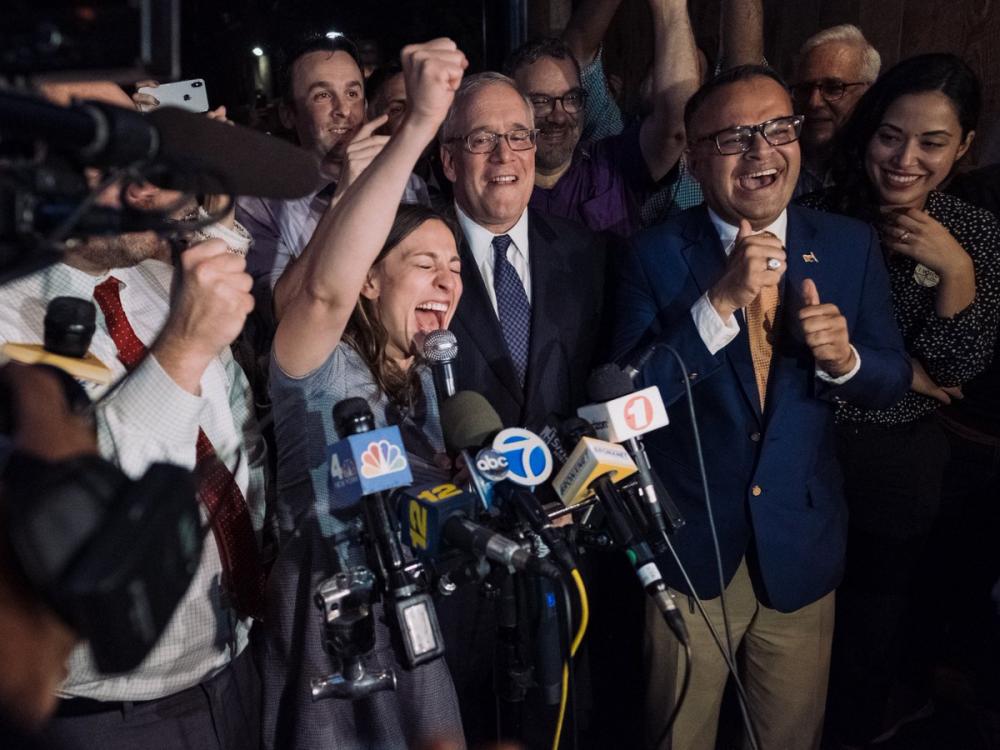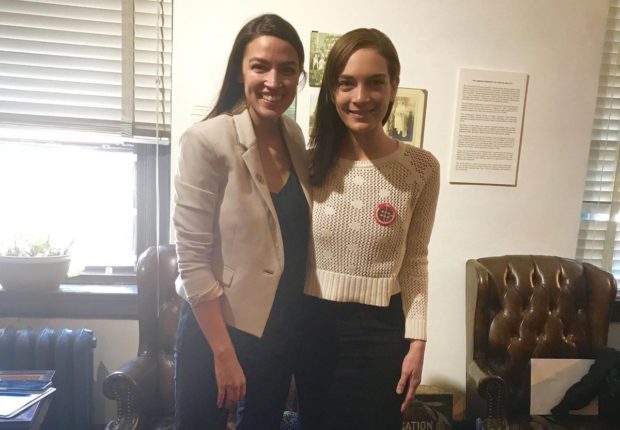The Progressive Playbook: How These Candidates Pulled Off Their Upsets; How Insurgent Forces Activated, Educated and Brought the IDC Down

The Progressive Playbook: How These Candidates Pulled Off Their Upsets - Astead W. Herndon and Kevin Roose (New York Times)
How Insurgent Forces Activated, Educated and Brought the IDC Down - Samar Khurshid (Gotham Gazette)
The Progressive Playbook: How These Candidates Pulled Off Their Upsets
Among the surprises this primary season were several high-profile upsets from the left. The Times asked some of the strategists and candidates behind these wins to break them down.
By Astead W. Herndon and Kevin Roose
September 15, 2018
New York Times
It has become a familiar pattern this primary season. The day after a surprising victory by a progressive underdog — say Alexandria Ocasio-Cortez of New York, Andrew Gillum of Florida, Jahana Hayes in Connecticut, Wesley Bell in Missouri or Ayanna Pressley in Massachusetts — national audiences rush to meet the latest Democrat who defied expectations.
Separately, every race has had its own challenges, but taken together, the group represents a sea change in the Democratic Party, which has repeatedly this primary season, seen its voters embrace candidates who are younger, more progressive and more diverse than the party’s establishment has been.
Certainly, Republicans have had their surprises. But “insurgency” on the conservative side has often meant the candidate most like President Trump in this primary season, particularly in races where Mr. Trump has offered his all-powerful endorsement on Twitter.
The New York Times spoke with the strategists, campaign managers and candidates at the front lines of progressive insurgent victories, in search of common threads that defined successful campaigns this election cycle.
Step 1: Have the right candidate in the right district

Credit: Whitney Curtis for The New York Times
A progressive candidate in a district full of moderate voters can overcome some ideological differences, and bring new voters into the process, through personality. A candidate’s life experience needs to reflect those of the voters she needs to convince, the group of experts said.
Before Ms. Pressley defeated a 10-term incumbent in Massachusetts’ Seventh Congressional District, she emphasized the unequal distribution of wealth in the Boston-area district that mirrored her own life: she grew up poor in Chicago, but attended a wealthy private school on the city’s North Side.
Mr. Bell was a city councilor from Ferguson, Mo., who campaigned on a platform of criminal justice reform to unseat a long-serving county prosecutor. He said progressive candidates need to “take the temperature of the room" and honestly determine the appetite for change.
“There has to be the right coalition — it has to be the right message, it has to be the right candidate,” he said.
The “right” candidate is particularly important in building coalitions for statewide races, the experts said. Progressive candidates like Abdul El-Sayed in Michigan and Cynthia Nixon in New York failed to draw support outside of urban centers. In Delaware, two days after Ms. Pressley’s victory, Kerri Harris had hoped to unseat an incumbent senator but secured only 35 percent of the vote.
Step 2: Take Advice from Silicon Valley: Test. Iterate. Repeat.
A nimble, grass-roots campaign must also be responsive to voter feedback, the experts said. Whether it’s listening to the advice of on-the-ground organizers, or tailoring digital messages to response patterns, the advantage of a nontraditional campaign should be its ability to quickly adjust.
“The whole point of digital is you can test what messages are working,” said Jessica Alter, the co-founder of Tech for Campaigns, a group of more than 8,000 tech workers who are volunteering to use their digital skills to help elect progressive candidates in November.
Testing different messages on small groups of Facebook users before launching a large-scale ad campaign, for example, could reveal that voters in a candidate’s district prefer positive ads to negative ads. Or, it could identify a national issue — say, immigration reform or marijuana legalization — that stirs up passions among a candidate’s target voter groups and might be a good subject to include in a stump speech. Testing messages online can even work for old-fashioned print advertising.
“If you’re going to spend $20,000 on direct mail, maybe spend $700 and test it on Facebook in a targeted way first,” she said.
Newer tools aren’t an automatic path to victory, of course. And social media popularity doesn't always translate to votes. In New York, Ms. Nixon dominated the conversation on Twitter, but she was handily defeated by incumbent Governor Andrew Cuomo, whose campaign quietly spent more than $2 million on digital advertising, with a heavy focus on Facebook.
Ms. Pressley’s campaign convened a weekly feedback circle of community leaders, local activists and volunteers. Sarah Groh, Ms. Pressley's 29-year-old campaign manager, said the advisers allowed the team to notice where their opponent was making gains. When the group felt some of the incumbent’s messages were beginning to take hold in the later stages of the race, they decided that Ms. Pressley should record another video ad, focused on delivering her final message to voters in an easy-to-digest fashion.
The video racked up 170,000 views on Twitter.

Credit: John Woike/Hartford Courant, via Associated Press // New York Times
Step 3: Don’t assume you know who the voters are
For these organizers, many of whom are taking principles from the activism world and applying them to electoral politics, a true grass-roots campaign means leaving no voter ignored — no matter the traditional wisdom. It also means splitting time between voters who are traditionally more likely to turn out in a primary (which trend older and whiter than a general election electorate) and “low-likelihood” voters (particularly minorities and younger voters). It’s a strategy that may rankle even the most supportive establishment consultants., who have often seen television as one benchmark of a candidate’s viability.
Jahana Hayes, a progressive Connecticut Democrat and former “Teacher of the Year” who won a landslide victory in her August Congressional primary, said she was driven by a sense of morality rather than horse-race politics.
“You have to be willing to lose,” she said.
“Everyone says, ‘You're not taking the right path,’ but I was just very firm that I don't want to just step into someone else's footprints: I want to create new footprints,” Ms. Hayes said.
Top campaign aides for Stacey Abrams’ historic gubernatorial bid in Georgia said a grass-roots strategy can work in larger voting pools, but it takes additional resources, too. Ms. Abrams’ campaign, which romped to victory by more than 50 points in May, reached out to 150,000 voters on Primary Day and about half a million voters over the four-day “get-out-the-vote” period during the campaign’s final stretch.
Step 4: Go ahead and embrace the left
Abolish ICE. No corporate PAC money. Medicare for all.
As national Democrats wrangle with incremental, politically pragmatic solutions to policy problems such as immigration and health care, progressive Democrats are offering bold, sweeping proposals.
“One of the things that we feel strongly about is that candidates run an unapologetically progressive campaign and speak authentically about the issues that they actually care about connect with voters,” said Maurice Mitchell, national director for the Working Families Party.
Mr. Mitchell cited the success of down-ballot progressives in the New York Democratic primary this week, even as Ms. Nixon’s gubernatorial campaign failed. Six Democratic insurgents knocked off more centrist Democratic incumbents behind uncompromising leftist messaging
The bold policy proposals gave liberals a progressive version of the Tea Party wave in the Republican Party — the angry, uncompromising conservative surge that consumed the party after President Obama’s election. It is also a rebuttal to the idea that progressive Democrats are simply against President Trump.
Ms. Groh, Ms. Pressley’s campaign manager, came to the campaign without any experience in traditional electoral races, but experience in issue-based grass-roots campaigns.
Ms. Groh said she believed voters craved a “level of authenticity,” and innovative policy solutions, delivered by the right messenger, can check that box.

Credit: Gabriela Bhaskar for The New York Times
Step 5: Redefine voter outreach
Ms. Hayes, Ms. Pressley and Ms. Ocasio-Cortez all won their congressional races without buying a traditional television advertisement. Instead, each created highly shareable, viral-focused campaign ads tailor made for social media. The ads focused more on the candidate’s biography than policy issues, and used slick cinematography.
Ms. Pressley’s campaign manager said ignoring television was the source of internal campaign battles, but the move allowed them to invest an additional $130,000 in field organizers. It also allowed the campaign to spend money on targeted media — including an advertisement on Spanish-language television and outreach on several ethnic media outlets in Boston.
Josi Nielsen, the Missouri political strategist who managed Mr. Bell’s election, said the campaign advertised in community newspapers, which have a small but deeply engaged audience.
“If the message resonates, the challenge is reaching enough people,” Ms. Nielsen said.
This year’s insurgent candidates have also looked to another, new not-so-secret weapon: text messages. Several relied on peer-to-peer texting apps like Hustle and Relay to reach huge numbers of voters directly on their cellphones.
Ms. Pressley’s team started using Hustle on August 9, initially for event building and volunteer recruitment.
The campaign communicated with 4,800 volunteer prospects through the service — 25 percent of them replied to the texts, and close to 8 percent of those texted committed to help.
During the campaign’s final days, the campaign initiated conversations with 26,500 voters, reaching out with over 41,000 messages in total.
“Hustle is a game changer for grass-roots organizing and fund-raising. It allowed us to connect with so many different parts of the district and was an important piece in our path to victory,” said Gina Christo, Ms. Pressley’s campaign finance director.
[Kevin Roose is a columnist for Business Day and a writer-at-large for The New York Times Magazine. His column, “The Shift,” examines the intersection of technology, business, and culture. @kevinroose • Facebook ]
How Insurgent Forces Activated, Educated and Brought the IDC Down
by Samar Khurshid
September 18, 2018
Gotham Gazette

photo: @Biaggi4NY // Gotham Gazette
Hit the ground early. Educate the electorate. Reach new voters. Go viral.
Those are a few of the strategies that propelled insurgent candidates to victory in last week’s primary elections, wherein six challengers prevailed over sitting Democratic state senators who were once members of the Independent Democratic Conference, a breakaway faction that caucused with Republicans for seven years, creating or padding the GOP majority in the chamber.
The upsets in the state Senate races instantly shook up New York politics and painted a picture of a more engaged Democratic electorate that would no longer tolerate party officials who don’t pass a particular purity test imposed by a progressive base angered by the election of Donald Trump and a lack of action on favored legislation in Albany.
The eight-member IDC, which dissolved in April amid mounting criticism of its role in keeping the state Senate in Republican hands, saw six of their own defeated on Thursday despite outspending their opponents and leveraging broad institutional support. Their conventional campaign tactics failed to overcome a coordinated crop of candidates backed by a vast network of grassroots activists who employed guerilla tactics to get their message heard and were, in several instances, bolstered by key established players.
In early 2017, in the aftermath of Trump’s election, a disparate movement focused on the IDC had begun to take shape. Under a Trump presidency, the IDC members and their power-sharing agreement with Republicans became unacceptable to these activists, who insisted on being represented by “true blue” Democrats. After a raucous townhall in early February 2017 where IDC Senator Jose Peralta met the fury of some, one grassroots group, Rise and Resist, began to hold regular protests against IDC members. Then, in May 2017, the incipient anti-IDC movement held simultaneous rallies across New York City, protesting outside the offices of the senators. By then, only one candidate had emerged, Robert Jackson, who beat Senator Marisol Alcantara in Manhattan’s 31st District by a wide margin. “The beginning of the real grassroots energy behind getting rid of the IDC started then,” said Lisa DellAquila, an anti-IDC activist turned campaign manager for John Liu, the last of the challengers to declare and who handily defeated IDC Senator Tony Avella in the primary.
It was the first volley in a broader, longer game that crescendoed to a fever pitch ahead of primary day. In interviews, the organizers, activists, and strategists behind the effort portrayed a campaign that laid the groundwork long before other candidates had even emerged. “Our strategy from day one was run nine challengers against nine traitors,” said Gus Christensen, chief strategist for No IDC NY, a grassroots group, referring to the IDC senators and Senator Simcha Felder, a rogue Brooklyn Democrat who was not part of the IDC but votes with Republicans. The activists eventually coalesced into the True Blue coalition, made up of about 60 groups, many local ones based in the districts represented by IDC senators, where organizing and education efforts increased awareness of the IDC over the course of 2017 and into this year. The coalition marshalled its resources, encouraging candidates to run while informing voters more broadly about the existence of the IDC.
“What the IDC did violated the public trust in a visceral, almost biblical way,” Christensen said. “The cynics of the political establishment could never see that, because caucusing with the other party isn't illegal, while Albany is full of actual illegal activities about which voters don't seem to care. But once enough voters understood that the IDC really did caucus with the GOP, that it wasn't ‘fake news,’ they were revolted, and they voted that way.”
Hitting the ground running
“One really important piece of this was just good old-fashioned organizing,” said Heather Stewart, co-founder of Empire State Indivisible, who later went on to work for Liu’s campaign doing communications. Stewart said the coalition began educating voters about the IDC last year through town halls, leafleting, phone banks, and on-the-ground outreach. “So there was a good deal of tracks laid through the education piece. This was over a year ago...it was a coalescence of great candidates, good organizing, people who wanted more than anything from the bottom of their heart to oust the IDC.”
The groups gathered every month to discuss strategy, and began to circle possible candidates who had expressed interest while actively recruiting others such as Liu, who entered the fray at the eleventh hour after having lost to Avella four years ago but with stronger name recognition in his district than most of the other challengers had in theirs at the start of their campaigns.
The groups also partnered with The Creative Resistance, a volunteer collective of documentary filmmakers, and released a video, titled “Lulu Land” and narrated by actor Edie Falco, about the IDC and its highly scrutinized arrangement for its members to inappropriately receive extra stipends. The video raised much-needed awareness for their effort. “By and large, people were enraged about the IDC,” said Stewart, who has acknowledged she only learned of the IDC in recent years, spurring her to action. “They were mad that they had voted for a Democrat who wasn’t upholding Democratic values.”
Different groups were assigned to different districts under one umbrella. “We borrowed a strategy from Virginia activists who flipped the House of Delegates,” Stewart said, “which was basically that each group adopted a campaign and a candidate. So then, each group could begin to engage their members in one consistent campaign...It worked very well...There was essentially a captain who captained the grassroots efforts in each campaign that talked with other captains of the grassroots effort.”
The overall effort was bolstered by the likes of the Working Families Party, Make the Road Action, and Citizen Action of New York, some of the organized left’s longer-standing infrastructure, groups that share similar progressive goals and sent hundreds of volunteers into the nine districts, relying on a robust ground game to activate voters.
“We started working as far back as spring of 2017, way before there even were candidates running, to start organizing in the districts of the IDC members, doing really aggressive voter contact and community organizing to help people understand what was actually going on,” said Joe Dinkin, WFP’s campaign director. “That helped till the soil, build a grassroots base of anger and energy and a volunteer base from which it was a lot more appealing for candidates who would think about running to be able to get into the race.”
Dinkin said the WFP, which endorsed all the candidates, provided campaign expertise, helping them strategize, hire staff and consultants, and dispatch volunteers. By February and into March of this year, the WFP had endorsed the full slate of challengers to the IDC senators, establishing clear battle lines within the Democratic Party and setting the stage for the essential stretch of the primary campaign well in advance.
The WFP was also behind the two insurgent statewide candidates who failed in the primary -- Cynthia Nixon lost to Cuomo by a wide margin and City Council Member Jumaane Williams failed to unseat Lieutenant Governor Kathy Hochul in a closer race. Zephyr Teachout, who the WFP said it was supporting along with eventual winner Letitia James in the attorney general Democratic primary, was unsuccessful in her race but amplified anti-IDC sentiment. Nixon was vocal about the IDC and when Cuomo moved to reunite the faction with the mainline Senate Democratic Conference, she claimed credit.
“Cynthia Nixon was able to broadcast in a way that the entire media and the political class and voters noticed about the problems with the IDC and how they were roadblocking progressive legislation,” Dinkin said.
The candidates themselves had also been beating the anti-IDC drum in their districts. “Typically campaigns run a eight-week, sometimes 12-week field operation,” said Andre Richardson, campaign manager for Zellnor Myrie, who defeated former IDC Senator Jesse Hamilton in Brooklyn. “We’ve been canvassing, paid and volunteer, and candidate canvassing for eight months. In politics, folks have these archaic strategies of ‘this is too soon, this is too early.’ We proved all of that to be inaccurate and we proved that if you run a consistent and aggressive ground game, you can win.”
Each of the candidates managed fairly robust fundraising operations, and focused mostly on individual small donors throughout their campaigns as they critiqued their opponents for receiving funds from corporate donors. There was, of course, a fair share of spending by the coalition groups to augment each campaign’s own operations. No IDC NY formed its own multi-candidate campaign committee and tapped hundreds of small donors as well, and spent nearly $150,000, across the Senate races.
Depending on digital
In order to build name recognition against the IDC members, some of whom have been incumbents for several terms, the broader coordinated campaign, individual candidates, and activist groups decided to focus their efforts on digital and social media, hyper-targeted to specific populations within each district.
All the campaigns and their allies outspent the IDC senators on Facebook, said Jim Casteleiro, digital director for No IDC NY, who coordinated efforts with The Creative Resistance to craft ads across all the campaigns.
“We started early in the summer conceiving of a plan to run digital ads in all the districts that we were targeting,” Casteleiro said. “Our sort-of guiding principle in this whole process was, ‘Yes, people are outraged about what’s happening with Trump. Yes, people are outraged about the IDC. But if we don’t talk to them about what this actually means for their lives, then no one’s gonna care’...All of the content that we created, it was all issue-focused.”
The ads focused on everything from the state’s housing crisis, immigrant protections, and health care to education funding and abortion rights, while introducing the slate of progressive challengers as individual people. Another round of more negative ads portrayed each of the IDC senators as a gas station tube man, full of hot air. All told, the 38 videos they created received more than a million views.
“Obviously, digital isn’t new necessarily,” Casteleiro said. “But what I say is kinda unprecedented is this: you have an all-volunteer organization that raises $250,000, we partner with an all-volunteer group of creative professionals who create agency-level content, and we deploy that across the state in a coordinated fashion…That has to be absolutely unprecedented in New York State.”
Activist Sean McElwee, writing in HuffPost, noted that grassroots group Vote Tripling got 474 volunteers to convince three friends each to vote for the IDC challengers, and national group Postcards to Voters sent 283,857 handwritten notes to get out the vote in those districts.
Eric Rockey, co-founder of The Creative Resistance and director of the “Hot Air” ads, said they were inspired by Alexandria Ocasio-Cortez’s viral campaign ad when she beat Democratic giant Joe Crowley in a June congressional primary that shocked the city, state, and country. The ad was like a “short documentary film about a candidate and less like a slick political ad,” he said, noting that his group skyped with the makers of that ad and also consulted with the team behind Cynthia Nixon’s campaign launch video.
“The strategy was really to find those unique issues that would be wedge issues between our candidates and IDC members and really hammer on those,” Rockey said. “It was really burnishing the progressive bonafides of these candidates. But also trying to show them as people.”
Convincing Candidates
No message is complete without its messenger and the anti-IDC movement was no different. The candidates they backed, most of them young progressives running for the first time, presented an alternative to the calcified establishment to a Democratic primary electorate that showed it was hungry for change.
By and large, the candidates were charismatic, energetic, and able to talk policy -- some with youthful exuberance, some with seasoned perspective.
Some were also backed by prominent elected officials, including City Council Speaker Corey Johnson and Comptroller Scott Stringer, both of whom brought organizing and fundraising with them. Myrie, in particular, received tremendous support from city, state, and federal elected officials, including many in Brooklyn. The powerful labor union 32BJ also played a prominent role in a few races, especially where Alessandra Biaggi defeated Klein, who once led the IDC and was, until Thursday, one of the state's most powerful elected officials. Stringer and Johnson and their teams were also all-in for Biaggi.
“We proved through heart and hustle and just organizing that it was possible,” she said in a phone interview. “I worked tirelessly and I’m unrelenting, and also a fighter and I’ve always been that way. And every time that somebody told me ‘no’ I worked double as hard and every time somebody told me ‘yes’ I worked triple as hard.”
Klein spent more to try to push back Biaggi’s challenge than Nixon did in her statewide race against the governor. “This race proved that the political currency is people, not dollars,” Biaggi said.
“They were all really great. They were easy to work for and easy to get people excited about. And that’s where the magic was if you ask me,” said Empire Indivisible’s Stewart about the IDC challengers.
In July, once Liu declared he would challenge Avella, the district was ready to hear from him. “A lot of work had already been done in his district. We already had boots on the ground there who were really fiercely committed to the IDC resistance and so it was essentially bringing in a great candidate,” Stewart said.
While Liu, Jackson, Biaggi, Myrie, Jessica Ramos, and Rachel May were successful in defeating former IDC members, other former IDC Senators Diane Savino and David Carlucci held onto their seats. Felder defeated Blake Morris. (Another insurgent leftist, Julia Salazar, unseated Senator Martin Dilan, though that race was not a focus of the same progressive, anti-IDC coalition.)

Photo twitter @SalazarSenate2018) // La Voce di New York
The primary winners are all-but-certain to win their general elections, if they have an opponent. The main remaining question is whether the anti-IDC efforts that toppled rogue Democrats can now help flip Republican-held seats and give the next Senate Democratic Conference, infused with new blood, an elusive majority. That answer will be known on November 6.
Again in the general, candidates and campaigns will both matter greatly.
Richardson, from Myrie’s campaign, explained some of the energy behind his candidate’s success. “Zellnor is in the top five of the most fearless candidates I’ve ever worked for,” he said. “In terms of his aggressiveness to talk to a voter, to hear a problem, his ability to immediately respond or to follow through, is pretty phenomenal…We had a pool of over 400 volunteers. And some of that was outreach. A lot of that was just organic because Zellnor was such a great candidate. Folks would just walk in the door or read an article about him and just wanna help.”
“We were really inspired by these candidates,” said Rockey. “It wasn’t a stretch for us. We were genuinely inspired by them. It felt like something new in New York politics...It was really about these personal connections with these candidates and our passion for these candidates.”
[Samar Khurshid is City government reporter, Gotham Gazette.]
